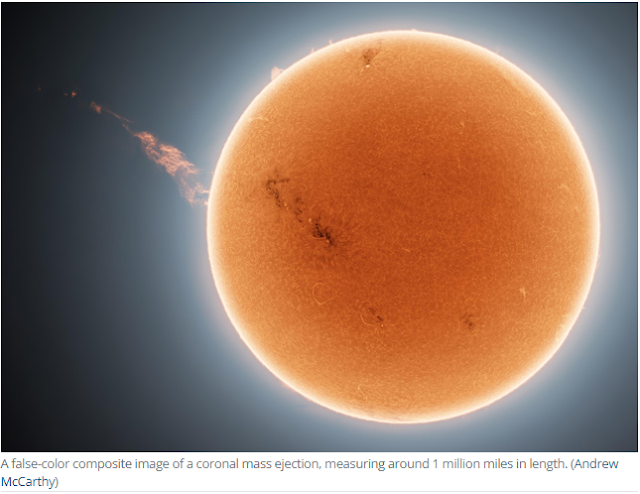An astrophotographer has acquired a stunning image of a gigantic plasma plume erupting from the Sun.
According to the photographer, the blazing filament, known as a coronal mass ejection (CME), reached into space more than 1 million miles (1.6 million kilometres) from the solar surface.
Andrew McCarthy, an Arizona resident and professional astrophotographer, captured the shot on September 24 and uploaded it to the subreddit r/space on September 25.
According to SpaceWeather.com, the CME was a part of a weak solar storm – G-1 class, the lowest category on the National Oceanic and Atmospheric Administration's (NOAA) Geomagnetic Storm Scale – and was directed away from Earth.
McCarthy said on Reddit that the ethereal expulsion was "the largest CME I've ever witnessed."
McCarthy said that the plasma was first trapped in a massive loop attached to the Sun's surface, known as a prominence, before breaking off and escaping into space at approximately 100,000 mph (161,000 km/h).
McCarthy noted that the image is a composite time-lapse photograph composed of hundreds of thousands of photographs shot over a six-hour period.
Every second, between 30 and 80 photos were recorded and stored in a file with a maximum size of approximately 800 gigabytes. The photos were then merged to display the CME in exquisite detail.
In the photograph, the Sun's surface and CME appear orange, but they are not orange in reality. Hydrogen-alpha, or H-alpha, light is naturally emitted by the chromosphere (the Sun's lowest atmosphere) and coronal mass ejections (CMEs). This light appears pinkish-red to us.
However, because the exposure time for each image was so brief, the original photographs were nearly entirely white. McCarthy digitally added the orange to the final image in order to generate contrast between the many structures on the solar surface and to emphasise the CME.
As the remainder of the image was not orange-filtered, the Sun's ghostly white halo stands out against the dark background of space.
CMEs have been increasingly frequent in recent months as the Sun has approached the solar maximum, a period of enhanced solar activity that lasts approximately seven years. This will increase the number of opportunities for individuals to capture comparable photographs.
McCarthy wrote, "We'll see more of these as the solar maximum progresses." He said that the plasma plumes are likely to get "progressively larger."
The photographer cautioned against observing the Sun without the correct equipment.
McCarthy posted on Reddit, "Do not aim a telescope towards the Sun." You will either damage your camera or, worse, your eyes.
He stated that the telescope he used to photograph the CME was "specially modified with several filters" in order to observe and photograph the CME safely.






0 Comments